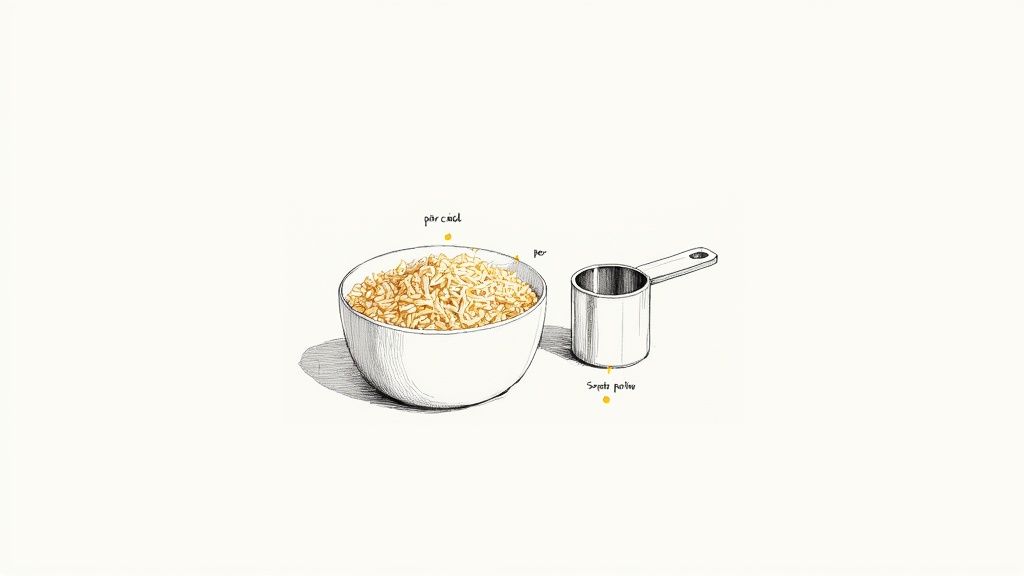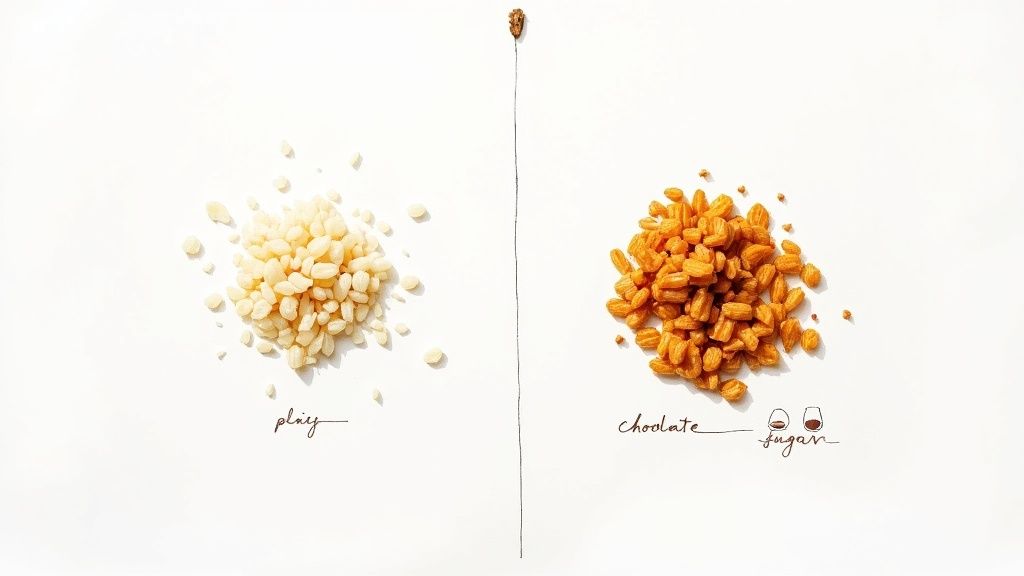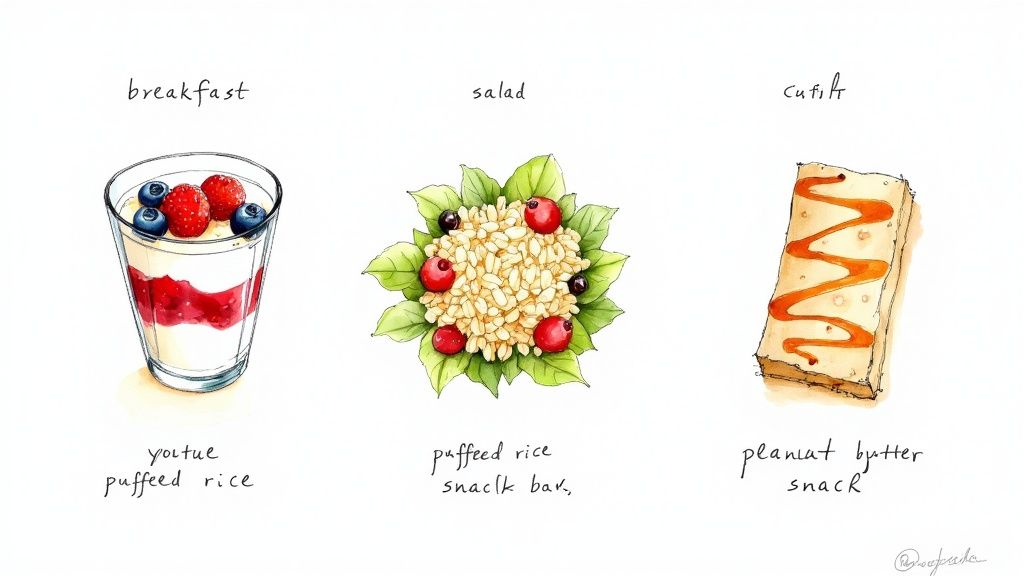Puffed Rice Calories: Your Quick Guide to a Super-Light Snack
puffed rice calories decoded: quick nutrition facts, snack comparisons, and easy tracking tips.
Posted by
Puffed rice is famous for being incredibly light on calories, which is exactly why it's a go-to for anyone wanting a crunchy, satisfying snack without the guilt. A standard cup of plain, air-puffed rice has only about 50-60 calories. If you're looking at a larger 100-gram serving, you're in the neighborhood of 380 calories.
Your Quick Guide to Puffed Rice Calories

But what do these numbers actually mean when you're grabbing a bowl? Let's break it down in real-world terms.
The magic of puffed rice is that it’s mostly air. This means you get a ton of volume for a tiny calorie price tag, making it a fantastic choice when you need a satisfying crunch but don't want to blow your whole day's calorie budget.
Puffed Rice Nutrition at a Glance (Plain)
To give you a clearer picture, here’s a quick reference for the nutritional stats of plain puffed rice. Think of these as the "base model" numbers before you add any tasty extras.
| Serving Size | Approx. Calories | Carbs (g) | Protein (g) | Fat (g) |
|---|---|---|---|---|
| 1 Cup (~14g) | 55 | 12g | 1g | <0.5g |
| 30g Snack Portion | 115 | 26g | 2g | <1g |
| 100g | 380 | 86g | 7g | 1g |
These numbers are a great starting point for understanding how puffed rice fits into your day. For a bigger-picture look at structuring your daily intake, you could explore something like a comprehensive 2000 calorie meal plan to see how it all comes together.
The best part? You don't have to memorize any of this.
When you grab a handful, just tell munchlog.ai, "I had a bowl of puffed rice," and it handles the logging for you. Knowing the numbers is cool for building awareness, but tracking should always be that simple.
Why Not All Puffed Rice Is Created Equal

Have you ever looked at the nutrition facts on a box of chocolate-puffed cereal and thought, "Wait, this is way higher than the plain kind"? You’re not wrong. The number you see for basic "puffed rice calories" is really just the starting point.
Think of plain, air-puffed rice as a blank canvas. It’s mostly just rice and air, which is why it's so light and low in calories. But as soon as other ingredients join the party, the nutritional landscape shifts dramatically.
How Add-Ins Stack Up
Even seemingly small tweaks can have a noticeable impact. Some puffed rice, for example, is roasted in oil instead of just being air-puffed. That little bit of oil gives it a richer flavor and a crunchier texture, but it also adds fat and nudges the calorie count up.
Of course, the biggest calorie culprits are the coatings and sweeteners that turn a simple grain into a breakfast treat.
- Sugar Glazes: A shiny, sugary coating can easily double the calories and carbs.
- Honey or Maple Drizzles: These might sound healthier, but they're still sugars and add a significant calorie load.
- Chocolate or Yogurt Coatings: These are a double whammy, adding both sugar and fat, making the snack far more calorie-dense.
This isn’t about demonizing any particular food. It's simply about being aware of what you're eating. The best way to see these differences for yourself is by getting comfortable with food labels. If you want to get better at this, learning how to read nutrition labels like a pro is a game-changer for making informed choices at the store.
The good news is, you don’t have to be a nutritionist to track these variations accurately. When you use a voice-logging app like munchlog.ai, all you have to do is say what you ate. Describing your snack as "a bowl of chocolate puffed rice" instead of just "puffed rice" gives the AI everything it needs to fetch the correct data, keeping your food log precise with zero extra effort.
Eyeballing Portions Without a Food Scale
Let's be real—nobody wants to whip out a food scale for a simple snack. And when it comes to something as light and airy as puffed rice, trying to guess a "serving size" can feel impossible. A heaping bowl looks like a lot, but it might weigh almost nothing.
This is where getting good at visualizing portions comes in handy. Instead of getting hung up on exact grams, you can use simple, everyday objects as a guide to get a pretty accurate estimate. It’s all about building an intuitive feel for portioning that makes tracking feel less like a chore.
Your Everyday Portion Cheat Sheet
Think of it this way: your standard cereal bowl probably holds about two cups of puffed rice. A quick handful? That’s closer to half a cup. These simple visual cues are often all you need to stay in the right ballpark.
- A Cupped Handful: Perfect for a quick, on-the-go snack. This is roughly half a cup.
- A Standard Cereal Bowl: Filled up, this will be around two cups.
- A Coffee Mug: A great way to keep your portion in check. This holds about one cup.
The real goal here is to be mindful, not meticulous. A good visual estimate is far more sustainable in the long run than chasing perfect measurements every single time.
This stress-free approach is exactly how munchlog.ai is built to work. You don't have to translate your portion into grams. Just say, "I had a handful of puffed rice," and the AI figures out the nutritional info for your log.
It’s about making tracking fit seamlessly into your life, not the other way around. While a scale has its place, you can learn more about striking the right balance in our guide on how to weigh food for weight loss. Using your voice removes all the friction, so you can just focus on enjoying your food.
Puffed Rice Compared to Other Popular Snacks
https://www.youtube.com/embed/NfassplthxU
So, how does a bowl of puffed rice really stack up against other snacks calling your name from the pantry? It’s easy to get lost in the numbers, but a quick comparison can put the puffed rice calories into perspective. Let’s do a friendly side-by-side to see how it fares.
The goal here isn’t to label anything "good" or "bad"—it's all about understanding the trade-offs. You might find that for the exact same weight, some snacks pack a much bigger calorie punch, which is super useful to know depending on your goals for the day.
Snack-Off: Puffed Rice vs. Other Favorites
Let's look at a typical 30-gram serving (about one ounce), which is a pretty standard size for a single-serving bag of chips or a decent handful of pretzels.
| Snack (30g serving) | Calories | Fat (g) | Carbs (g) |
|---|---|---|---|
| Plain Puffed Rice | 115 | <1g | 26g |
| Air-Popped Popcorn | 110 | 1g | 22g |
| Pretzels | 115 | 1g | 23g |
| Potato Chips | 160 | 10g | 15g |
As you can see, puffed rice lands right in the same ballpark as other low-fat, carb-forward snacks like popcorn and pretzels. The real game-changer, though, is the volume. Thirty grams of puffed rice is a heaping bowl, while thirty grams of chips is just a small handful. It offers a whole lot of crunch for its calorie cost.
The biggest takeaway here is that puffed rice gives you more volume for your calories. This can be a huge help for satisfying hunger and cravings without accidentally overdoing it on your energy intake.
This visual gives you a great idea of how to eyeball puffed rice portions without ever needing a scale, from a simple handful to a full bowl.

It really shows how a "bowl" of puffed rice can feel incredibly satisfying while staying low in calories.
Knowing these simple comparisons makes logging your food so much faster. Telling munchlog.ai, "I had a small bag of chips" versus "I had a big bowl of puffed rice" paints two very different nutritional pictures. For more tips on tracking light snacks, check out our guide on the calories in a fruit bowl.
Creative Ways to Enjoy Puffed Rice

Puffed rice is so much more than a bland snack you eat straight from the bag. Its incredibly light, airy texture and fairly neutral flavor make it a fantastic culinary chameleon. It can add a satisfying crunch to just about anything you can think of.
Forget complicated recipes for a moment. This is about simple, creative ways to add texture and volume to your meals. We're talking about easy swaps that make your food more interesting without piling on the calories.
Simple Ideas for Everyday Meals
It's surprisingly easy to get creative with puffed rice. The goal is to add that "crunch factor" in places you might not expect.
- Breakfast Parfait: Try layering puffed rice with your favorite yogurt and some fresh berries. The result is a creamy, crunchy breakfast that feels more like a dessert.
- Salad Topper: Ditch the heavy, oil-soaked croutons and sprinkle a handful of puffed rice over your salad instead. You get all the crunch with none of the grease.
- No-Bake Snack Bars: This one's a classic for a reason. Mix puffed rice with a bit of peanut butter or melted dark chocolate, press the mixture into a pan, and let it chill. Simple, homemade energy bars.
The love for puffed rice isn't just a local thing, either. It reflects a much bigger trend—global rice consumption is projected to hit a massive 542 million metric tons by 2026. This growing popularity has cemented puffed rice as a staple ingredient around the world, proving just how versatile it is. You can dig into more of these global food trends to see how they shape what we eat.
The best part about making your own creations? You're in charge of every ingredient. That means you have total control over the puffed rice calories in your final snack.
This is where a voice tracker really shines. When you log a homemade meal, you don't want to break down every single component. Just say, "I had a yogurt parfait with puffed rice and strawberries," and a tool like munchlog.ai gets it right. It's built to understand real, everyday food, making tracking your creative meals completely seamless.
Your Top Puffed Rice Questions, Answered
Got questions about puffed rice? You're not alone. Let's tackle some of the most common ones so you can feel good about adding this light, crunchy food to your plate.
So, Is Puffed Rice Actually Healthy?
Plain puffed rice is a fantastic starting point. By itself, it’s a simple, low-calorie, low-fat carbohydrate that brings a satisfying crunch and volume to your meals. It's what you do with it that counts.
Think of it like a blank canvas. When you pair it with fruit, nuts, or yogurt, you're creating a nutritious snack. But when it’s drenched in sugary syrup or roasted in oil, its health benefits start to take a backseat.
Does Puffed Rice Have Any Real Nutritional Value?
While it’s not going to win any awards against superfoods like quinoa, puffed rice has its own unique strengths. Its biggest asset is being a low-density food, meaning you get to eat a large, satisfying portion for a surprisingly small number of calories. That’s a huge win for managing hunger.
Plus, many brands you find at the store are fortified with important vitamins and minerals, like iron and B vitamins. A quick glance at the nutrition label will tell you if your go-to brand has these added nutritional perks.
The real magic of puffed rice is its ability to crush a craving for something crunchy with a tiny calorie footprint. It's one of the smartest swaps you can make for high-calorie snacks.
Can Puffed Rice Help Me With My Weight?
Absolutely. It can be an incredibly helpful food if you're keeping an eye on your weight. Since the puffed rice calories are so low for such a big volume, it lets you enjoy a satisfying snack without blowing your calorie budget.
Think about it: a big bowl of plain puffed rice feels much more substantial and filling than a small handful of potato chips, often for a fraction of the calories. The trick is to stick with the plain versions and be conscious of what you’re adding to it.
How Can I Log All These Different Puffed Rice Snacks Correctly?
This is where a voice-first tracker like munchlog.ai really makes a difference. Instead of trying to find a generic entry that doesn't quite fit, you just say what you ate.
For instance, you could log "a bowl of chocolate puffed rice cereal with milk" or "a handful of savory masala puffed rice." The AI understands the nuances and pulls up the right nutritional information, accounting for the extra sugar, spices, or oil. It removes all the tedious guesswork and keeps your food log accurate and effortless.
Ready to stop guessing and start tracking effortlessly? With munchlog.ai, you can log your meals just by talking. It's the simplest way to stay mindful of your nutrition without the hassle of manual entry. Try it today and see how easy food tracking can be.